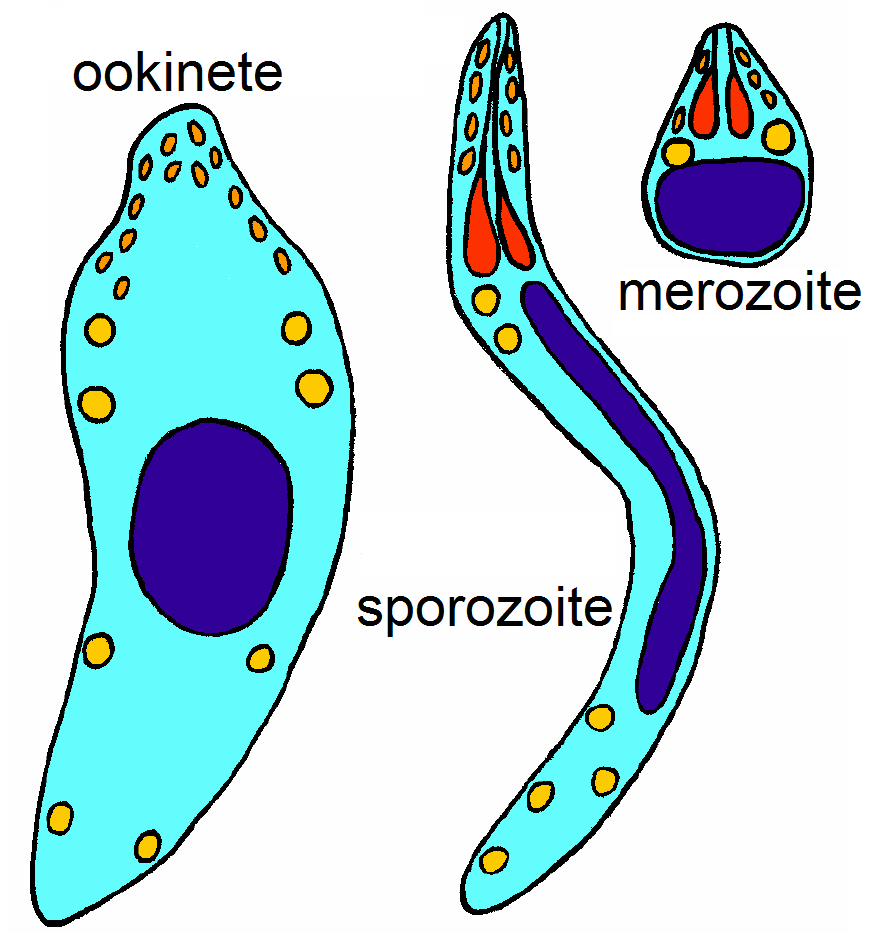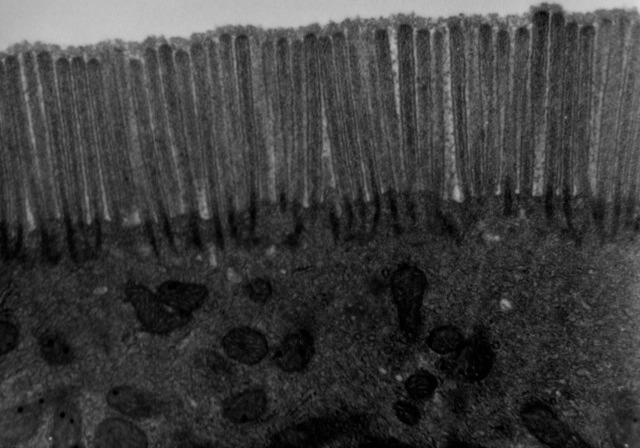|
Meroselenidium Keilini
''Meroselenidium'' is a genus of parasitic alveolates in the phylum Apicomplexa. Species in this genus infect marine invertebrates. Taxonomy This genus was described by Doris Mackinnon, Mackinnon and Ray in 1933. There is one species in this genus – ''Meroselenidium keilini''. Description The trophozoites live within the gut lumen. They measure 200–300 μm × 40–70 μm. There are 30–40 grooves along the body. Four refringent rods are present in the mucron. A vacuole may also be present in the mucron. Schizogony occurs in the intestinal epithelium and gives rise to multiple merozoites. Synergy is caudo-caudal. The gametocysts are 70 μm × 55 μm and give rise to multiple gametes. After fertilization the zygote gives rise to ~20 sporocysts. There is no residual body. The sporocysts are bivalved and give rise to multiple sporozoites. The species in this genus, ''Merselenidium keilini'', forms transversely striated folds. Life cycle This species in ... [...More Info...] [...Related Items...] OR: [Wikipedia] [Google] [Baidu] |
Eukaryota
Eukaryotes () are organisms whose cells have a nucleus. All animals, plants, fungi, and many unicellular organisms, are Eukaryotes. They belong to the group of organisms Eukaryota or Eukarya, which is one of the three domains of life. Bacteria and Archaea (both prokaryotes) make up the other two domains. The eukaryotes are usually now regarded as having emerged in the Archaea or as a sister of the Asgard archaea. This implies that there are only two domains of life, Bacteria and Archaea, with eukaryotes incorporated among archaea. Eukaryotes represent a small minority of the number of organisms, but, due to their generally much larger size, their collective global biomass is estimated to be about equal to that of prokaryotes. Eukaryotes emerged approximately 2.3–1.8 billion years ago, during the Proterozoic eon, likely as Flagellated cell, flagellated phagotrophs. Their name comes from the Greek language, Greek wikt:εὖ, εὖ (''eu'', "well" or "good") and wikt:� ... [...More Info...] [...Related Items...] OR: [Wikipedia] [Google] [Baidu] |
Doris Mackinnon
Doris Mackinnon (30 September 1883 – 10 September 1956) was a British zoologist. Born in Scotland, her father was a Consular Agent and her mother managed a "women's home". Influenced by Maria Gordon, Mackinnon studied botany and geology at Aberdeen University, graduating in 1906. She received the "Carnegie scholarship", studying abroad for two years before returning to Scotland. She achieved her doctorate from Aberdeen University in 1914, becoming a lecturer at University College, Dundee (the forerunner of the University of Dundee, but then a part of the University of St Andrews) in 1916. During World War I, Mackinnon worked in military hospitals in Britain, researching and helping to diagnose amoebic dysentery. Her work in the military hospitals fuelled her interest in the topic, which she focused on during the following years. In 1919, Mackinnon joined King's College London as a lecturer and became Chair of Zoology in 1927, the first female Chair at the college. She re ... [...More Info...] [...Related Items...] OR: [Wikipedia] [Google] [Baidu] |
Polychaete
Polychaeta () is a paraphyletic class of generally marine annelid worms, commonly called bristle worms or polychaetes (). Each body segment has a pair of fleshy protrusions called parapodia that bear many bristles, called chaetae, which are made of chitin. More than 10,000 species are described in this class. Common representatives include the lugworm (''Arenicola marina'') and the sandworm or clam worm ''Alitta''. Polychaetes as a class are robust and widespread, with species that live in the coldest ocean temperatures of the abyssal plain, to forms which tolerate the extremely high temperatures near hydrothermal vents. Polychaetes occur throughout the Earth's oceans at all depths, from forms that live as plankton near the surface, to a 2- to 3-cm specimen (still unclassified) observed by the robot ocean probe ''Nereus'' at the bottom of the Challenger Deep, the deepest known spot in the Earth's oceans. Only 168 species (less than 2% of all polychaetes) are known from ... [...More Info...] [...Related Items...] OR: [Wikipedia] [Google] [Baidu] |
Zygote
A zygote (, ) is a eukaryotic cell formed by a fertilization event between two gametes. The zygote's genome is a combination of the DNA in each gamete, and contains all of the genetic information of a new individual organism. In multicellular organisms, the zygote is the earliest developmental stage. In humans and most other anisogamous organisms, a zygote is formed when an egg cell and sperm cell come together to create a new unique organism. In single-celled organisms, the zygote can divide asexually by mitosis to produce identical offspring. German zoologists Oscar and Richard Hertwig made some of the first discoveries on animal zygote formation in the late 19th century. Humans In human fertilization, a released ovum (a haploid secondary oocyte with replicate chromosome copies) and a haploid sperm cell (male gamete) combine to form a single diploid cell called the zygote. Once the single sperm fuses with the oocyte, the latter completes the division of the ... [...More Info...] [...Related Items...] OR: [Wikipedia] [Google] [Baidu] |
Merozoites
Apicomplexans, a group of intracellular parasites, have life cycle stages that allow them to survive the wide variety of environments they are exposed to during their complex life cycle. Each stage in the life cycle of an apicomplexan organism is typified by a ''cellular variety'' with a distinct morphology and biochemistry. Not all apicomplexa develop all the following cellular varieties and division methods. This presentation is intended as an outline of a hypothetical generalised apicomplexan organism. Methods of asexual replication Apicomplexans (sporozoans) replicate via ways of multiple fission (also known as schizogony). These ways include , and , although the latter is sometimes referred to as schizogony, despite its general meaning. Merogony is an asexually reproductive process of apicomplexa. After infecting a host cell, a trophozoite ( see glossary below) increases in size while repeatedly replicating its nucleus and other organelles. During this process, the orga ... [...More Info...] [...Related Items...] OR: [Wikipedia] [Google] [Baidu] |
Intestinal Epithelium
The intestinal epithelium is the single cell layer that form the luminal surface (lining) of both the small and large intestine (colon) of the gastrointestinal tract. Composed of simple columnar epithelial cells, it serves two main functions: absorbing useful substances into the body and restricting the entry of harmful substances. As part of its protective role, the intestinal epithelium forms an important component of the intestinal mucosal barrier. Certain diseases and conditions are caused by functional defects in the intestinal epithelium. On the other hand, various diseases and conditions can lead to its dysfunction which, in turn, can lead to further complications. Structure The intestinal epithelium is part of the intestinal mucosa. The epithelium is composed of a single layer of cells, while the other two layers of the mucosa, the lamina propria and the muscularis mucosae, support and articulate the epithelial layer. To securely contain the contents of the intes ... [...More Info...] [...Related Items...] OR: [Wikipedia] [Google] [Baidu] |
Schizogony
Fission, in biology, is the division of a single entity into two or more parts and the regeneration of those parts to separate entities resembling the original. The object experiencing fission is usually a cell, but the term may also refer to how organisms, bodies, populations, or species split into discrete parts. The fission may be ''binary fission'', in which a single organism produces two parts, or ''multiple fission'', in which a single entity produces multiple parts. Binary fission Organisms in the domains of Archaea and Bacteria reproduce with binary fission. This form of asexual reproduction and cell division is also used by some organelles within eukaryotic organisms (e.g., mitochondria). Binary fission results in the reproduction of a living prokaryotic cell (or organelle) by dividing the cell into two parts, each with the potential to grow to the size of the original. Fission of prokaryotes The single DNA molecule first replicates, then attaches each copy to a d ... [...More Info...] [...Related Items...] OR: [Wikipedia] [Google] [Baidu] |
Vacuole
A vacuole () is a membrane-bound organelle which is present in plant and fungal cells and some protist, animal, and bacterial cells. Vacuoles are essentially enclosed compartments which are filled with water containing inorganic and organic molecules including enzymes in solution, though in certain cases they may contain solids which have been engulfed. Vacuoles are formed by the fusion of multiple membrane vesicles and are effectively just larger forms of these. The organelle has no basic shape or size; its structure varies according to the requirements of the cell. Discovery Contractile vacuoles ("stars") were first observed by Spallanzani (1776) in protozoa, although mistaken for respiratory organs. Dujardin (1841) named these "stars" as ''vacuoles''. In 1842, Schleiden applied the term for plant cells, to distinguish the structure with cell sap from the rest of the protoplasm. In 1885, de Vries named the vacuole membrane as tonoplast. Function The function and ... [...More Info...] [...Related Items...] OR: [Wikipedia] [Google] [Baidu] |
Mucron
A ''mucron'' is an attachment organelle found in archigregarines - an order of epicellular parasitic Conoidasida.Simdyanov TG, Guillou L, Diakin AY, Mikhailov KV, Schrével J, Aleoshin VV. (2017) A new view on the morphology and phylogeny of eugregarines suggested by the evidence from the gregarine ''Ancora sagittata'' (Leuckart, 1860) Labbé, 1899 (Apicomplexa: Eugregarinida) PeerJ 5:e3354 https://peerj.com/articles/3354/?td=wk The mucron is derived from the apical complex, which is found in all members of the phylum Apicomplexa.Adl SM, Simpson AG, Lane CE, Lukeš J, Bass D, Bowser SS, Brown M, Burki F, Dunthorn M, Hampl V, Heiss A, Hoppenrath M, Lara E, leGall L, Lynn DH, McManus H, Mitchell EAD, Mozley-Stanridge SE, Parfrey LW, Pawlowski J, Rueckert S, Shadwick L, Schoch C, Smirnov A, Spiegel FW. (2012) The revised classification of eukaryotes. Journal of Eukaryotic Microbiology 59:429-514. https://doi.org/10.1111/j.1550-7408.2012.00644.x The mucron is located at the anterior ... [...More Info...] [...Related Items...] OR: [Wikipedia] [Google] [Baidu] |
Phylum
In biology, a phylum (; plural: phyla) is a level of classification or taxonomic rank below kingdom and above class. Traditionally, in botany the term division has been used instead of phylum, although the International Code of Nomenclature for algae, fungi, and plants accepts the terms as equivalent. Depending on definitions, the animal kingdom Animalia contains about 31 phyla, the plant kingdom Plantae contains about 14 phyla, and the fungus kingdom Fungi contains about 8 phyla. Current research in phylogenetics is uncovering the relationships between phyla, which are contained in larger clades, like Ecdysozoa and Embryophyta. General description The term phylum was coined in 1866 by Ernst Haeckel from the Greek (, "race, stock"), related to (, "tribe, clan"). Haeckel noted that species constantly evolved into new species that seemed to retain few consistent features among themselves and therefore few features that distinguished them as a group ("a self-contain ... [...More Info...] [...Related Items...] OR: [Wikipedia] [Google] [Baidu] |
SAR Supergroup
The SAR supergroup, also just SAR or Harosa, is a clade that includes stramenopiles (heterokonts), alveolates, and Rhizaria. The name is an acronym derived from the first letters of each of these clades; it has been alternatively spelled "RAS". The term "Harosa" (at the subkingdom level) has also been used. The SAR supergroup is a node-based taxon. Note that as a formal taxon, "Sar" has only its first letter capitalized, while the earlier abbreviation, SAR, retains all uppercase letters. Both names refer to the same group of organisms, unless further taxonomic revisions deem otherwise. Members of the SAR supergroup were once included under the separate supergroups Chromalveolata ( Chromista and Alveolata) and Rhizaria, until phylogenetic studies confirmed that stramenopiles and alveolates diverged with Rhizaria. This apparently excluded haptophytes and cryptomonads, leading Okamoto ''et al.'' (2009) to propose the clade Hacrobia to accommodate them. Phylogeny Based on a ... [...More Info...] [...Related Items...] OR: [Wikipedia] [Google] [Baidu] |


